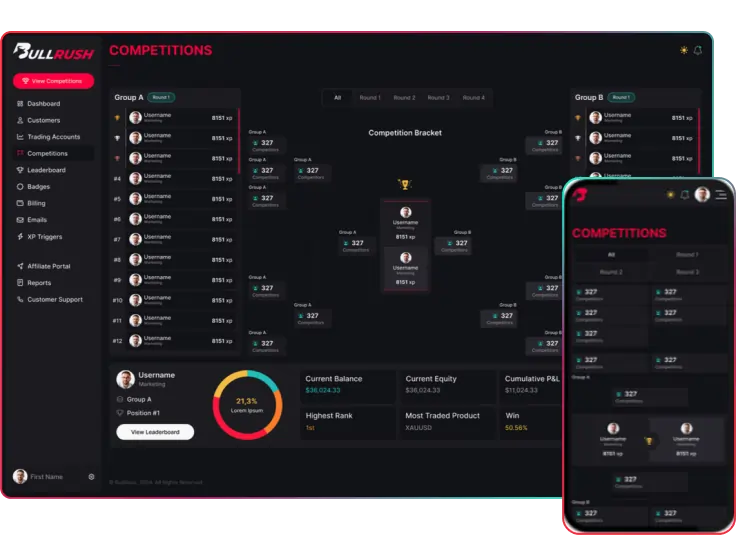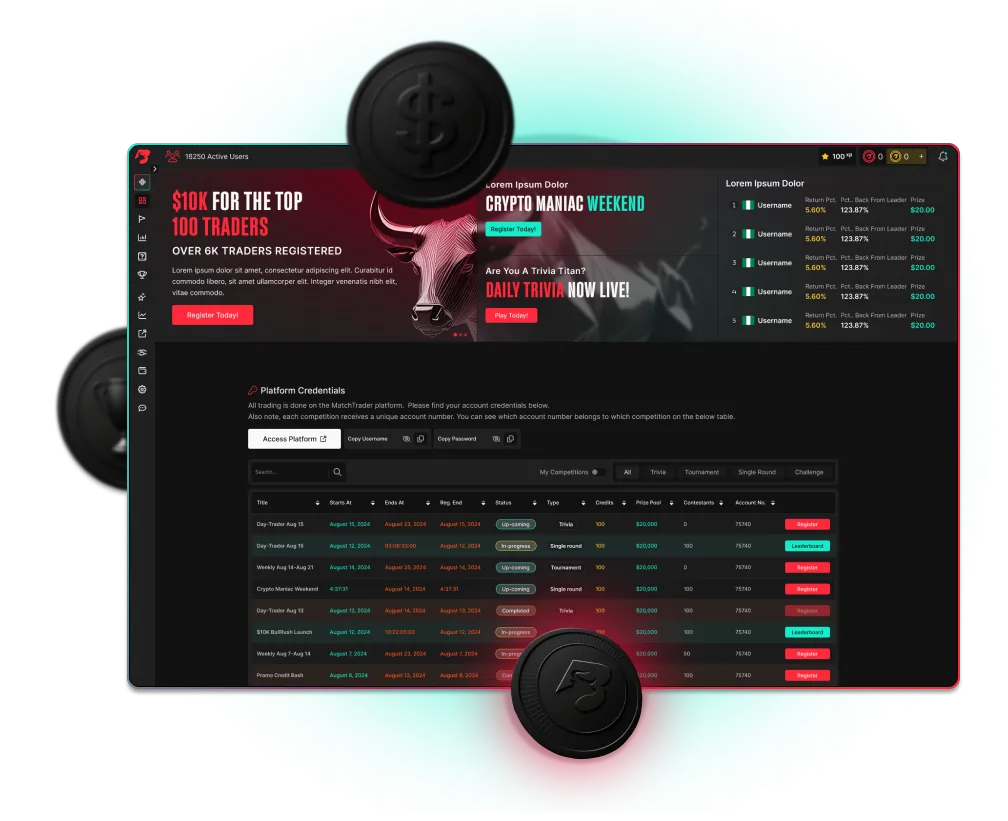THE GAME JUST
GOT BIGGER!
SPORTS COMPETITIONS
ARE HERE.
Make your picks, climb the leaderboard, rule the competition.
REAL A-BOOK
PROP TRADING
Real Markets. Real Rewards.
Trade with Confidence Backed
by Full Transparency.
THE ULTIMATE
TRADING ARENA
TRADE. COMPETE. WIN.
Where Traders Battle for
Bragging Rights and Big Rewards!
FANTASY SPORTS
SUPERCHARGED
Live odds. Smart Picks. Big wins.
Make your picks, climb the leaderboard,
rule the competition.
Join a trading competition or free sports picks to level up your skills
Think your trading or sports skills are unbeatable? Prove it! Join a trading contest or sports picks at BullRush, compete in a gamified format, win real prizes and prop firm challenges.
Join, compete, Win big.
It is easy to get started. Join now and start competing.
Popular Competitions
Competition favourites
Crypto Weekend 12/5 - 12/7
Weekly Competition - Dec 8- 12
Battle Of The Bulls
Weekly Competition - Dec 15- 19
Profit Sprint - 12/8 - 12/19
All Sports Competition Dec
Competitions Starting Every Single Day

The Benefits
What Makes Us Different

Win Instant Prizes

Compete against the market and other players in a series of skilled based competitions and challenges.

BullRush offers both trading and sports picking competitions.

Hourly, daily, weekly, and season long competitions.
Process Steps
How It Works


Sign Up For The System
Enter basic details about yourself. You need to be 18+ and live in one of the regions we are authorized.


Pick Your Competitions
Choose trading tournaments, trading challenges or sports picks. BullRush lets you compete on demo competition accounts, ensuring a level playing field with virtual capital for all participants.


Start Competing
Open your demo competition account and trade Bitcoin, forex, or other markets. Short-term and long-term contests test your strategy and decision-making skills.


Track Performance
Follow your progress on the competition leaderboard and see how you rank against other traders.


Win Cash and Prizes
Top performers earn prop firm challenges, XP points, and exclusive rewards, including promo credits for future competitions.
BULLRUSH SPORTS
WELCOME TO
THE NEXT LEVEL OF COMPETITION
BullRush is now more than trading. With real sports picking competions, your instincts, strategy and sports knowledge are all that stand between you and cash prizes.
ONE PLATFORM, TWO ARENAS
You're probably wondering the same
Frequently
Asked
Questions
What are Trading Competitions?
A trading competition is a competition where traders compete to see who is the best trader. Each participant receives a demo trading account with $100,000.
Participants all trade for a set duration and the traders with the highest % return in their account are crowned the winners.
What are Sports Picking Competitions
BullRush fuses fantasy sports and sports betting into one intense, skill-driven competition. Each competitor is given a virtual bankroll to place picks with. Money lines, spreads, player props, in-game picks, single picks and even parlays. The user with the largest bankroll at the end of the competition wins the prize.
Are there any fees to participate?
Registering to BullRush is free. Inside the dashboard you can register for free competitions as well as paid competitions and challenges.
Entry fees range from $5-$500 and are matched with the prizes given away.
How do I join a competition?
To join a competition, register for BullRush at https://bullrush.tech/auth/signup and click on the 'Register' button one or multiple competitions.
How do I win prizes?
Each competition has specific winning criteria but most common way to win is to reach the highest PnL amongst all the participants.
Our automated platform distributes awards to the winners based on the pre-set criteria.
IN THE PRESS









Ready to Start Competing?
Sign up now and join the world of fantasy trading and fantasy sports!
Compete, win, and grow with BullRush.


